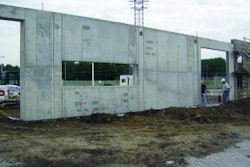
Construction spending posted a tiny increase in October, the first advance in six months, as a surge in home building offset continued weakness in nonresidential construction.
The small gain is a hopeful sign that the key construction sector might be stabilizing, which could provide support for the fledgling economic recovery.
The Commerce Department said Tuesday that construction spending edged up 0.04 percent in October, or $401 million, pushing the seasonally adjusted annual rate to $910.8 billion. That was better than the 0.5 percent decline economists expected, but it followed five straight drops including a 1.6 percent fall in September that was the largest since January.
The monthly construction report is often subject to major revisions. The September drop originally was reported as an increase of 0.8 percent.
But the new report appears to signal that the construction sector is starting to stabilize, which would be good news for the economy as it emerges from the worst recession in decades.
The strength in October came from a 4.4 percent jump in residential construction, the largest advance in home building since March 1998. The increase pushed residential activity to a seasonally adjusted annual rate of $250.3 billion in October, still 23.6 percent below the year-ago level.
The October surge partly reflected a rush by builders to get housing started before the expiration of a tax credit of up to $8,000 offered by the government to first-time homebuyers. The incentive had been scheduled to expire on Nov. 30, but President Barack Obama earlier last month signed into law a measure that extends the tax credits for first-time buyers through June as long as they sign a binding contract by April 30. The program also was expanded to include a $6,500 credit for existing homeowners who buy a new place after living in their current residence for at least five years.
Nonresidential construction fell 2.5 percent in October, the seventh consecutive decline, pushing activity down to an annual rate of $338.6 billion. That's 20.6 percent below the year-ago level as spending on office buildings, hotels and the category that includes shopping centers all showed weakness.
A credit squeeze is hurting nonresidential construction as banks, struggling through the worst financial crisis since the 1930s, have tightened up loan standards due to soaring loan defaults in the commercial sector.
Spending on government construction dipped 0.4 percent in October to an annual rate of $321.8 billion. A 0.9 percent drop in spending on state and local government projects offset a 4.6 percent rise in federal spending.
The overall economy, as measured by the gross domestic product, expanded at an annual rate of 2.8 percent in the July-September quarter, weaker than the initial 3.5 percent estimate. Still, it marked the first positive GDP growth following a record four consecutive quarterly declines.
The worry is that the fledgling recovery could falter, especially if consumers become more fearful about the future as the unemployment rate, already at a 26-year high of 10.2 percent, is expected to keep rising until next summer.

















